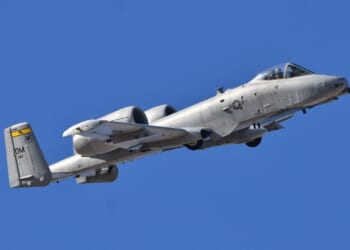China’s Fujian carrier has successfully developed electromagnetic catapults—leapfrogging the US Navy, which mostly uses steam-powered catapults and has struggled to implement electromagnetic ones.
Chinese state media broadcaster CCTV shared its first footage on Monday of the People’s Liberation Army Navy (PLAN) successfully conducting an electromagnetic catapult-assisted takeoff and arrested landing on the deck of the Type 003 Fujian aircraft carrier. In the roughly 90-second video, Shenyang J-15T and Shenyang J-35 fighters and Xi’an KJ-600 airborne early warning and control (AEW&C) could be seen carrying out the launch tests of the advanced catapult systems during previous sea trials aboard China’s first domestically-built catapult-equipped flattop.
The Type 003 Fujian is the first Chinese carrier to be outfitted with three advanced electromagnetic catapult systems, which are similar to the United States Navy’s EMALS (Electromagnetic Aircraft Launch System) employed on the Gerald R. Ford-class nuclear-powered carriers.
The PLAN’s two previous carriers, the Type 001 Liaoning and Type 002 Shandong, use ski-jump ramps, which are technically less sophisticated but limit the size, takeoff weight, and range of their air wings.
China’s Great Leapfrog in Aircraft Carrier Technology
Electromagnetic catapults are still a relatively new phenomenon in naval warfare. The US Navy’s Nimitz-class carriers still employ traditional steam-powered catapults, and the US Navy has struggled to resolve numerous issues with the EMALS. The problems with the system contributed to delays with the USS Gerald R. Ford (CVN-78)—to the extent that during President Donald Trump’s first term, he called for a return to the “proven” steam catapults, despite expert warnings that it would add billions of dollars to implement the changes.
The US Navy remained committed to the EMALS, despite their ongoing reliability issues. A Congressional Research Service report from August warned that the reliability goals will not likely be met until the 2030s.
Although electromagnetic catapults are more complex than steam-powered ones, they are actually mechanically simpler in design and far more compact. As Bloomberg explained, this allows them to “be easily configured to launch both light and heavy planes, putting less strain on the airframes.”
China has gotten the technology right from the start, likely by adopting a more straightforward approach. Analysts have suggested that what the EMALS employs is a complex linear induction motor; Chinese engineers opted for something conceptually less complicated—reportedly utilizing flywheels that store and release kinetic energy. That energy can be transferred from the flywheel to a winding drum, which in turn pulls the cable attached to the aircraft.
This design enabled China to leapfrog the use of steam-powered catapults, which, at least in the videos released to state media, appeared to work well.
“Beijing has not disclosed any of the circumstances around its electromagnetic catapults, including their maintenance and reliability,” Bloomberg added.
China Is Sharing News in Preparation for the Fujian’s Commissioning
Beijing remains secretive about sharing details of its military capabilities, and it likely waited until the tests were successfully completed before disclosing any information publicly.
The warship, which departed from the Changxing Island dock at the Jiangnan Shipyard in Shanghai earlier this month and is now operating in the South China Sea, had previously completed eight sea trials of its propulsion, electronic systems, deck operations, and catapults. The completion of the tests signifies that the Type 003 has achieved its initial full-deck operational capability.
This current deployment, believed to include the ninth set of sea trials to ensure all the systems are working accordingly, likely comes as there is growing speculation that the Type 003 Fujian will be officially commissioned into PLAN service on the National Day of the People’s Republic of China on October 1, which commemorates the founding of the nation after the Chinese Civil War in 1949.
About the Author: Peter Suciu
Peter Suciu has contributed over 3,200 published pieces to more than four dozen magazines and websites over a 30-year career in journalism. He regularly writes about military hardware, firearms history, cybersecurity, politics, and international affairs. Peter is also a contributing writer for Forbes and Clearance Jobs. He is based in Michigan. You can follow him on Twitter: @PeterSuciu. You can email the author: [email protected].
Image: Shutterstock / Jason Orender.
















